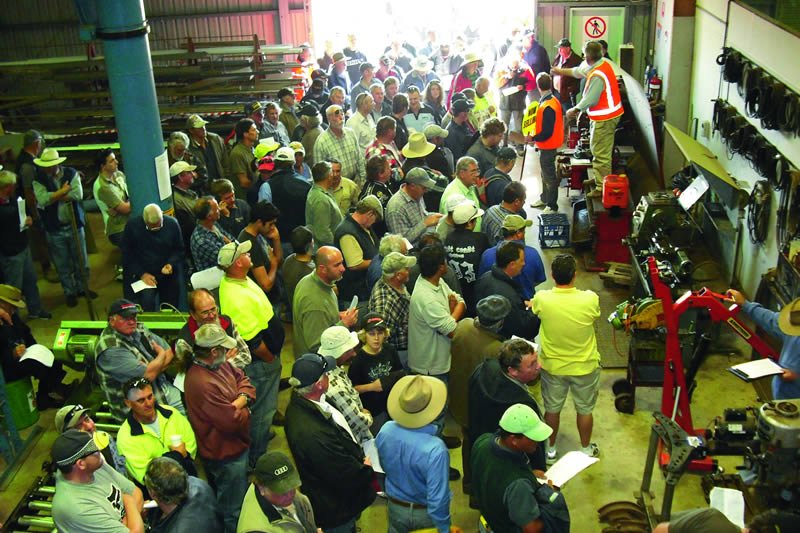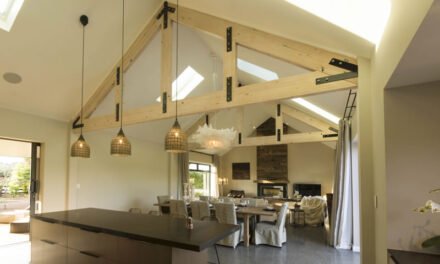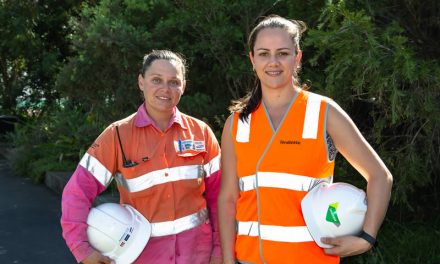Whether you’re wanting to sell up, to offload excess machinery or to buy something new, selling and buying through auctions or direct second-hand sales can represent a brilliant deal.
With record low interest rates and the Australian Government’s instant asset write-off continuing until 31 December, it’s a great market for machinery buyers if you have the credit. But do you need to be buying new? There’s a significant market of second-hand equipment – which also may qualify for the write-off – available for sale through both machinery specialists and at auction. It can fill your needs right now and help you grow your business until there’s more certainty in the economy.
We asked three experts for their tips on second-hand buying – and selling.
What am I bid?
David and Louise Purtle from Sydney Auctions recently managed the sale of plant and machinery for Truss-T-Frame Timbers. The well-known Illawarra fabrication business was being closed down after the land was sold and the owner decided to retire rather than go through all the stress of a move. Done entirely under Covid restrictions, Sydney Auctions managed everything, including the advertising, open days, online auction and pick-up and payments.
“We had 168 registered bidders,” says Purtle, “from Mt Isa to Melbourne to Busselton in WA. We had a 96% clearance for that one; everything we thought would sell, did, including a $90,000 table press.”
Before an auction, particularly online, site inspections allow potential buyers to inspect the machinery and see it in operation. “The people who looked at that table press did things like measure it and think about how it would fit in their factory,” says Purtle. “Mostly they just want to check it works and touch and feel it, because no one wants to spend that sort of money sight unseen.”
While potential buyers already know why they want a machine, Purtle recommends having a list of details, like the power supply in your factory and what sort of capacity and specifications you need for the productivity gains you expect. “Definitely do your homework on pricing and remember you’ll be paying auction and transport costs, too,” he says. “That said, the best buyer from our perspective is the guy who doesn’t understand the market and pays too much. It’s usually not a huge overpayment and it goes towards the vendor’s retirement, so even if he regrets it, he’s made someone else very happy.”
There’s usually a two- or three-day window to pick up your purchases from site, though that can change by arrangement. Purtle says, “The Truss-T-Frame table press was 3m wide by 15m long and weighed some 10 tonnes. We had to clear the other machinery out of the factory before we could fit in cranes and a truck so it could go, so it wasn’t picked up for three weeks.”
On the sellers’ side, Purtle sees three main groups. The first are Baby Boomers looking to retire, “the second are, sadly, those businesses that are going under because of Covid-19 or other market pressures. And then we also get some machinery from people who just want to upgrade their equipment,” he says.
Sydney Auctions works Australia-wide. As well as auctioneers, the team includes valuers. “On the valuation side we value plant machinery, businesses and real estate,” says Purtle. “On the selling equipment side, we can do online auctions, traditional auctions, sale by tender or expression of interest: whatever’s the best option for marketing that asset on behalf of a client.”
For sellers, an auction won’t necessarily guarantee you the highest prices on your item, but it will take the stress out of the job. “Once we agree on commercial terms, we effectively become the project manager,” Purtle says. “We come along, create an inventory of the assets and do all the marketing. We might get some help from the owner in cleaning up the product and the factory and making it safe for people to visit, but otherwise we effectively take responsibility for all of it, including the handover of the assets.
“And it’s all on a defined timeline: if a client says to me, ‘David, we’re closing our plant and my lease expires on 30 October’ then we can plan all our actions and give him a timeline of what will be happening on each date. We’re all done by the middle of October and he can just pack up his personal items.”
Purtle recommends that, prior to sale, sellers service their machinery, update any software that might be relevant, find the operating manuals and service history if any, clean the machine (and factory) and generally present it as well as possible.
Sellers may be able to get a higher price advertising directly, but Purtle says an accurate valuation is important. “Our experience is that if something is offered to the market too expensively in the first instance, say $20,000 for something more likely to sell at $16,000, it sits there for months and potential buyers psychologically devalue it, because it hasn’t sold. Eventually it might go for $12,000, and that’s taken months of your time, rather than an auction that’s completed in a set time frame.”
Trade in and up
Vekta Advanced Automation’s founder Ed Serrano is best known for his customisable Razer saw range. While most are sold new, there are sometimes second-hand models available. “We don’t get many, but we take ‘trade ins’ from customers who want to upgrade to the latest and greatest version of the Razer saw,” Serrano says. “So we effectively buy the old one and then bring it back to Perth, refurbish it and sell it on.”
With a steady demand for quality used saws, it’s a low-risk option for Vekta. And with the company’s philosophy of making all upgrades backwards-compatible and building to last for decades, it’s also a low-risk option for would-be buyers.
“The most likely sites to buy second-hand are ones looking to upgrade because they’re starting to grow, but they’re not quite ready to buy brand new,” says Serrano. “They want to jump up in terms of productivity and efficiencies, but they’re not ready to pull the trigger on a brand-new system, so they’ll buy second-hand and keep that until it starts to pay for itself and they get their efficiencies up, which makes it easier for them to buy the new equipment at a future date.”
The second-hand saw seller is a company that wants to replace it, and here Vekta’s business model represents a distinct advantage. Several years ago, they set up their own leasing facilities, so Vekta is able to offer a range of options. “They don’t want a delay between taking out the first saw and waiting to sell it before they buy the second – they can’t do business without a saw,” says Serrano.
“Because we already have the tools set up for our leasing agreements, it’s quite a straightforward process for us to tailor something to fit that sort of situation – whether that be a lease-to-buy agreement that will have the balance paid when the old saw is sold, or some other financing – and it works out really well. We find a solution that works for both parties, shake hands and put it into a document. We don’t have to go through a bunch of middle people and have all those third parties get involved.”
In some cases, Vekta can come in after work finishes at a factory on a Friday, take out the old saw and put in the new one over a weekend. “So there’s no interruption to their productivity and they can pick up from where they left off on the Monday morning,” Serrano says.
In terms of selling the old saw, there’s a demand for second-hand, so, as Serrano says: “It’s just a matter of giving it a bit of a once-over and then moving it on again.
“Usually we bring it back to Perth, upgrade the equipment and put all the bells and whistles on it. Our upgrades are always backwards-compatible. So, apart from some of the wear and tear items, which we can replace preventatively, the refurbished old machine is very similar in performance to a new machine,” Serrano adds.
Refurbish and redesign
Rob Armour, owner of frame and truss machinery company Framequip has long run a sideline in second-hand machinery. Unlike Vekta’s model, these come from a wide range of machinery manufacturers. “Most of these are suitable machines that I buy and rebuild on spec,” Armour says.
“A lot of them I hear about while I’m on site with another machine, while for others, people contact me through word of mouth because my reputation is out there.”
From saws and benches to tables, framing machines and nailers, Armour has long been dedicated to getting F&T plants up and running without huge expense. Occasionally, he also lists machines other businesses are selling on his website and charges a commission if he makes the sale. Armour makes sure each piece has good working life left in it, and, for the machines he is selling himself, gives a minimum of a clean-up and service, replacing parts as required.
As an engineer, Armour is happy to work with a buyer to offer a lot more than just a simple refurbishment, delivering a degree of control and customisation to buyers with constrained budgets.
“We specialise in customising and working to customers’ individual requirements,” Armour says. “We can do automated outfeeds, crossover outfeeds and curved conveyors – all motorised with pneumatic pop-up stops… We can completely change our designs to a customer’s specific request, as long as they sign off on the changes. Within reason – and as long as it abides by safety requirements – we can do almost anything a customer asks for.”
Currently, Armour is rebuilding a Spida 2000 with Mango Automation and an old Bostitch wall framing machine from the ground up, “while adding some new enhancements,” he says. Framequip also does autobench and rotary saw upgrades, plus software installation. The results mean that even in a downturn like this one, most plants can afford to retool and take advantage of opportunities as they arise.
For more, visit www.sydneyauctions.com.au, www.vekta.com.au and www.framequip.com.au











